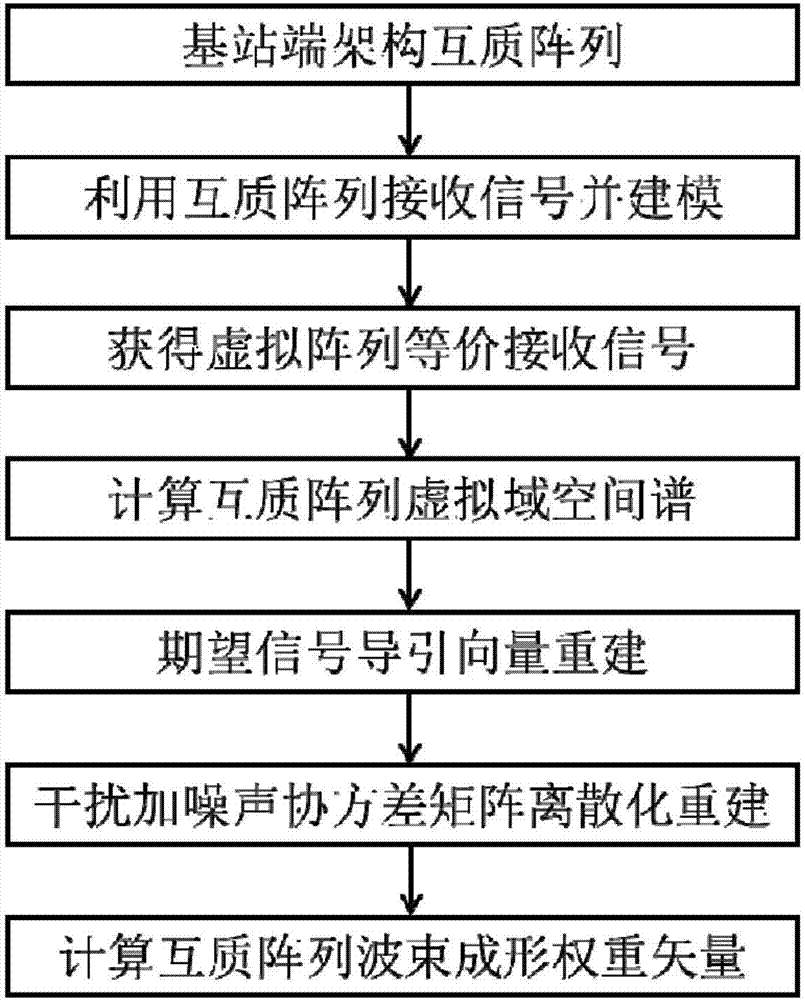Coprime array adaptive wave beam shaping method based on covariance matrix virtual domain discrete reconstruction
A covariance matrix, adaptive beam technology, applied in the field of signal processing, can solve problems such as limited degrees of freedom
- Summary
- Abstract
- Description
- Claims
- Application Information
AI Technical Summary
Problems solved by technology
Method used
Image
Examples
example 1
[0087] Simulation example 1: The virtual domain spatial spectrum P of the coprime array proposed by the present invention v (θ) is compared with the Capon space spectrum using a uniform array such as Figure 4 As shown, the signal-to-noise ratio is 30dB, and the number of sampling snapshots is L=500. The vertical solid line in the figure represents the desired signal direction, and the vertical dotted line represents the interference direction. Since the number of incident signal sources is greater than the number of physical antenna elements, the degree of freedom performance of the uniform array method is limited by the number of physical antenna elements, and cannot effectively distinguish all incident signal sources at the same time; in contrast, mutual Mass Array Virtual Domain Spatial Spectrum P v (θ) enables efficient estimation of all signal sources. It can be seen that the use of coprime array virtual domain equivalent signals can increase the degree of freedom of ...
example 2
[0088] Simulation Example 2: The beam pattern of the method proposed by the present invention is compared with the uniform array ideal beam pattern and the coprime array ideal beam pattern as shown in Figure 5. The vertical solid line in the figure represents the desired signal direction, and the vertical dotted line represents the interference direction. The ideal beam pattern of a uniform array is shown in Figure 5(a). Due to the limited degree of freedom performance, the method using a uniform array can only form 9 nulls even in an ideal situation. In addition, because it cannot effectively distinguish all interference source, its main lobe is not precisely aligned with the desired signal direction; in contrast, the coprime array ideal beam pattern shown in Figure 5(b) can form nulls in all interference directions, and guarantee The signal direction forms the main lobe, which shows that the degree of freedom performance of the adaptive beamforming method using coprime arrays...
example 3
[0089] Simulation Example 3: Comparison of the output SINR performance between the proposed method of the present invention and the uniform array sparse reconstruction method Image 6 and Figure 7 shown. At the same time, the optimal value of the output SINR is also given in the figure as a reference. For each set of parameter values, the number of Monte Carlo experiments is 1000. Fig. 5 is the graph of the relationship between the output SINR and the input SNR, and the number of sampling snapshots is set to L=500; it can be seen that the trend and the optimum of the output SINR of the proposed method of the present invention The values remain consistent and outperform uniform array sparse reconstruction methods. Image 6 is the relationship curve between the output SINR and the number of sampling snapshots, and the input SNR is set to 30dB; due to the limited performance of the degree of freedom, the output SINR of the uniform array sparse reconstruction method varies w...
PUM
 Login to View More
Login to View More Abstract
Description
Claims
Application Information
 Login to View More
Login to View More - R&D
- Intellectual Property
- Life Sciences
- Materials
- Tech Scout
- Unparalleled Data Quality
- Higher Quality Content
- 60% Fewer Hallucinations
Browse by: Latest US Patents, China's latest patents, Technical Efficacy Thesaurus, Application Domain, Technology Topic, Popular Technical Reports.
© 2025 PatSnap. All rights reserved.Legal|Privacy policy|Modern Slavery Act Transparency Statement|Sitemap|About US| Contact US: help@patsnap.com



